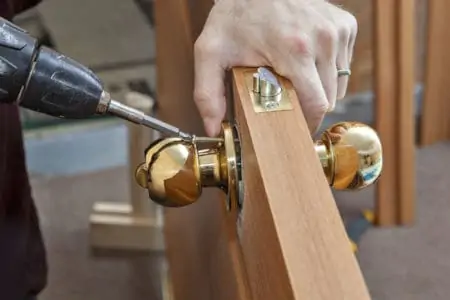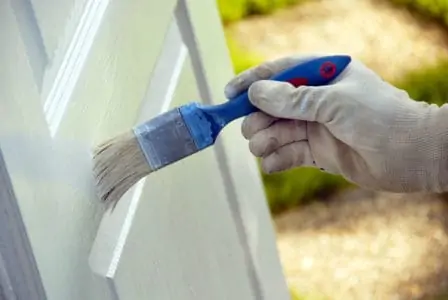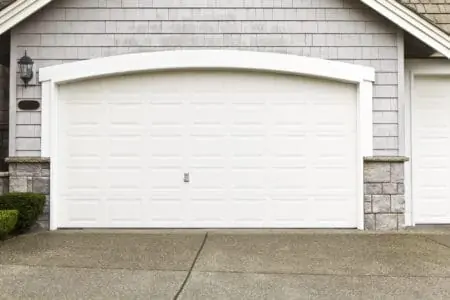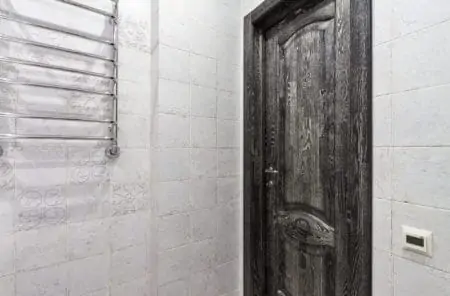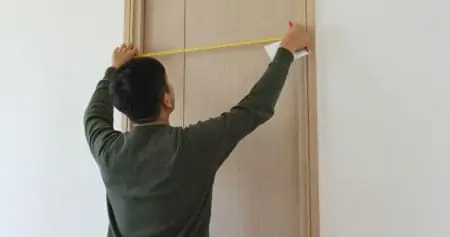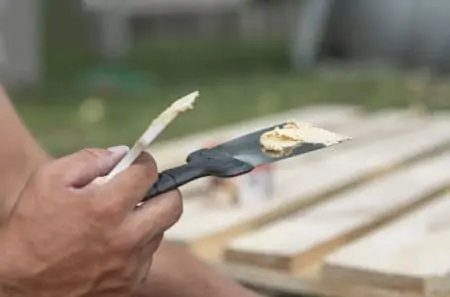Removing doorknobs may seem like a puzzle you can’t solve. Where are the screws, and how do you get to them? And not all doorknobs are the same, so knowing which type you have is crucial.
We teach you how to remove a doorknob in easy-to-follow steps and explain the different types available.
Key Takeaways
- Identify doorknob type: Half Dummy, Passage, Privacy, Storeroom, Keyed Entry, or Push Button.
- Gather tools: Flat-head screwdriver, Phillips screwdriver, paper clip, and possibly an Allen wrench.
- Remove screws or fasteners: Use the appropriate screwdriver or paper clip to remove the screws or fasteners holding the doorknob in place.
- Remove the doorknob and latch assembly: Carefully pull the doorknob free and remove the latch assembly from the door.
Types of Doorknobs
With so many types of doorknobs to choose from, knowing which one you have is vital if you plan to remove it. Some are easier than others, especially the half dummy and passage doorknobs. Here’s why:
Half Dummy
A half dummy doorknob has no locking mechanism and doesn’t need to be turned to operate it. It is used for interior pull open doors and side-to-side doors on cabinets and furniture.
Passage
Passage doorknobs are mainly used for interior doors and closets. These knobs sit on both sides of the door and turn but have no locking mechanism. A passage doorknob is suitable for any location where privacy is not essential.
Privacy
Privacy knobs feature a turn button lock on the inside knob. These are also intended for interior doors like bedrooms and bathrooms, where privacy is needed.
Storeroom
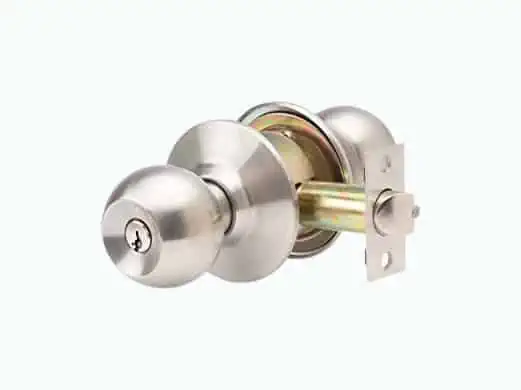
Storeroom doorknobs feature a lockable handle on the outside and a knob on the inside. The exterior lock remains locked unless opened with a key, and the interior knob turns freely.
Keyed Entry
Keyed entry doorknobs have a keyed access on the outside and turn button lock on the interior knob. They are perfect for exterior doors where the extra security of a deadlatch is required.
Push Button
Suppose you’ve forgotten your key, no problem. The push-button doorknob has a numbered panel to enable you to punch in a unique code to open the door. They give a higher level of security and are handy when you have lots of people coming and going but don’t have spare keys.
How to Remove a Doorknob With Screws
Removing a doorknob with screws is a lot easier than doorknobs with no screws visible.
But before we get into the nitty-gritty of removing the doorknob, first, we need to gather some tools to ensure the job is done correctly.
What You’ll Need
- Flat-head screwdriver.
- Phillips screwdriver.
- Check the doorknob to see if you can see the exposed screws.
- You should see one to three screws on the side of the door without the lock.
- If you can’t see screws on the cover plate, check the neck of the knob.
- Depending on the type of screws, grab the flat-head or Phillips screwdriver and loosen the screws by turning them counterclockwise.
- With the screws removed, pull the handle out of the latch assembly. Do this for the knob on the other side of the door.
- Remove the screws on the latch assembly and lift it out. If it is stuck, use the flat-head screwdriver for leverage.
- Now you can remove the latch mechanism (the bolt that fits into the strike plate).
How to Remove a Doorknob With Hidden Screws
Doorknobs with a cosmetic collar called the “rose” have concealed screws. They make the door hardware look neater and deter anyone from removing the knob from the outside.
What You’ll Need
- Flat-head screwdriver.
- Phillips screwdriver.
- Paper clip.
- You should see a small notch on the side of the cover plate. Grab the flat-head screwdriver and pry it off to reveal the screws beneath.
- Depending on the type of screw, use the flat-head or Phillips screwdriver to loosen the screws and remove them.
- Check for the recessed fasteners that were hidden by the cover plate. These are located at the base of the handle shaft.
- Insert the paper clip into the recess to loosen the fastener.
- Remove the doorknob and the spindle that connects both doorknobs.
- Remove the screws on the latch plate and use the flat-head screwdriver to pry it away from the door. Now you can take out the bolt.
How to Remove a Doorknob With a Push Button Lock
Removing a doorknob with a push-button lock is very similar to the previous technique. However, you may require an Allen wrench to complete this process.
What You’ll Need
- Flat-head screwdriver.
- Phillips screwdriver.
- Paper clip.
- Allen wrench.
- Flashlight.
- Locate the recessed slot in the shaft of the doorknob. Use the flashlight to see inside to check what type of fastener it has. If it is a hex shape, you will need to loosen it with the Allen wrench.
- With no screw, use the paper clip and depress the button to release the doorknob handle.
- If there is a screw, check to see if it is a Phillips or flat-head and use a screwdriver small enough to fit the hole. Turn the screw counterclockwise to remove it.
- Remove the handle part of the doorknob.
- To remove the spindle that connects both handles, use the flat-head screwdriver and pry off the cover plate.
- Loosen the concealed screws and place them somewhere safe.
- Now remove the spindle and the other doorknob.
- Unscrew the latch plate and remove the latch.
What to Do When a Doorknob Is Stuck
Sometimes you don’t need to replace the doorknob. It might only need a quick fix. However, if the internal mechanism is broken, you will need to replace the entire handle and latch.
- The most obvious signs the doorknob is stuck are:
- The latch will not retract after the handle is turned.
- The doorknob will not turn to retract the latch.
- It takes more effort to turn the door handle.
- The handle needs to be shaken to unstick the latch.
Check the Door Alignment
Sometimes your door drops slightly, making it misaligned. When that happens, the latch mechanism no longer meets the strike plate cleanly. It could cause the latch to stick or to fail to engage correctly.
Align the latch with the strike plate with the door shut and then adjust the height of the plate. This is the easiest fix. However, it could be the sign of wood expansion or an even bigger issue, like subsidence.
Unsticking a Stuck Door Latch
Moisture rusts door hardware, including latch plates and strike plates. Plus, other debris becomes lodged inside your door mechanism, causing the latch to stick. You could try blasting it with a lubricant, like WD:40.
WD:40 is actually a water displacer with a small amount of lubricant. Blasting the mechanism removes debris, and the latch should move freely.
Take Note: While this is a quick fix, using WD:40 may cause more debris buildup in the long run.
Try using a dry product, like this B’laster Graphite Spray, instead of a wet lubricant. It still keeps the latch mechanism moving, but it attracts less debris.
If that doesn’t work, try removing the handle and latch using one of the methods above and soak the mechanism in vinegar with 5 percent acidity. Vinegar is an excellent all-around cleaning product, and it is entirely natural.
Try a Short, Sharp Shock
With the door shut, try pulling or pushing it from the outside or inside, depending on how it opens. This sudden burst of pressure may loosen the stuck mechanism. Rattling the handle sometimes works to loosen the latch free.
If pulling the door doesn’t make a difference, try hitting the door just above or below the handle.
Release the Latch
If the latch doesn’t retract even with turning the handle, try inserting an old credit card into the gap between the latch plate and the strike plate. It may be the best way to unstick it and get the door open.
Top Tip
Only use an old credit card because it may snap.
And Finally
Removing a doorknob from your old front door is not a difficult task. All it takes are the right tools, a bit of planning, and a steady approach. You can complete the job in less than 10 minutes. We haven’t covered fitting the replacement doorknob, but that will undoubtedly be the subject of a different article.
The next time you have trouble with your door latch, don’t call the professionals; get out your tools and get stuck in.
